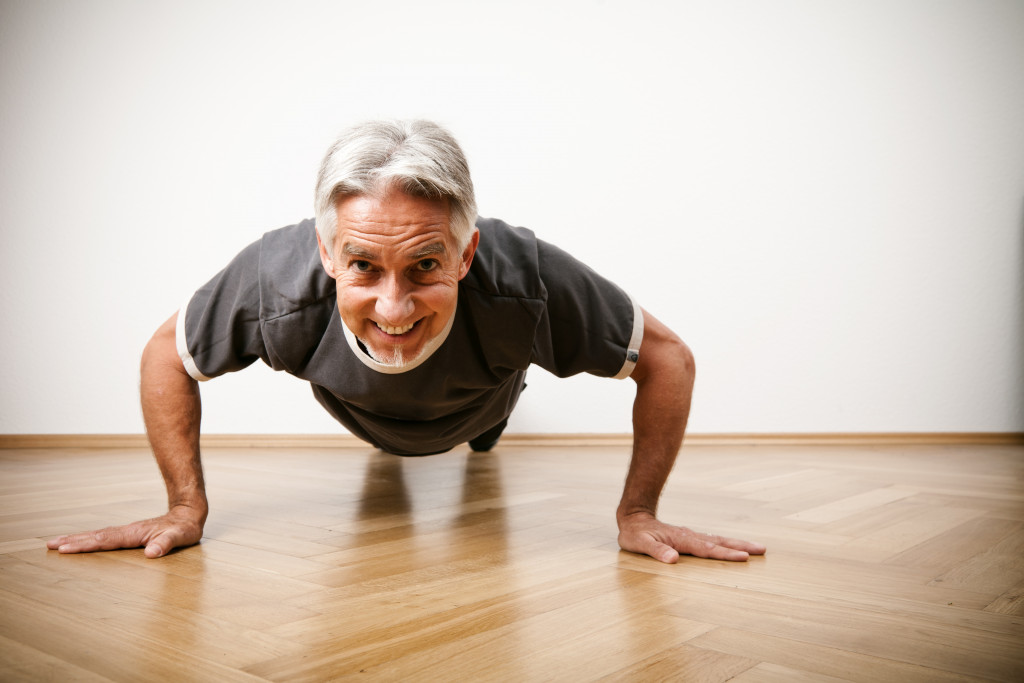- Regular physical activity in seniors reduces mortality risk and combats chronic diseases like heart disease and diabetes.
- Suitable exercises for seniors include low-impact aerobics, strength training, flexibility exercises, and walking.
- Regular doctor consultations and physical therapy sessions ensure safety and effectiveness in senior fitness regimes.
- A balanced diet, proper hydration, and careful medication management are essential for senior fitness.
Physical activity is crucial during retirement to ensure overall health and well-being. Regular exercise maintains physical health and enhances mental and emotional stability. According to the Centers for Disease Control and Prevention (CDC), seniors who engage in at least 150 minutes of moderate-intensity aerobic activity each week have a 33% lower risk of all-cause mortality than those who are inactive. Moreover, regular physical activity can reduce the risk of developing chronic conditions, like heart disease and type 2 diabetes, by up to 50%. Additionally, the World Health Organization (WHO) states that physical inactivity is recognized as the fourth leading risk factor for global mortality, emphasizing the need for regular exercise, especially in the elderly population.
Unfortunately, you might find engaging in regular physical activity challenging due to certain health conditions, such as muscle weakness, joint pain, and chronic fatigue. Here are a few tips for seniors to help make physical activity a part of their daily routine:
Identify the Suitable Exercises

As we age, our body undergoes various changes, including reduction in muscle mass, decreased bone density, and reduced flexibility. The right type of exercise can help combat these changes, improve overall health, and enhance quality of life. Identifying suitable practices is crucial to ensure safety, prevent injuries, and accomplish the desired health benefits. The exercise regimen should align with the individual’s health status, physical capabilities, and interests.
Low-Impact Aerobics
Low-impact aerobic exercises, such as swimming and cycling, are excellent for seniors as they place minimal stress on the joints while increasing cardiovascular fitness. These exercises are especially beneficial for those with arthritis or osteoporosis as they enhance muscle strength, improve balance, and increase endurance.
Strength Training
Strength training is essential to counteract the natural decline in muscle mass and strength with age. Resistance exercises, such as lifting weights or resistance band workouts, help maintain muscle mass, improve balance, and prevent falls.
Flexibility and Balance Exercises
Exercises like yoga and tai chi enhance flexibility, improve balance, and promote mental well-being. They can help reduce the risk of falls, a common concern in older people, and improve mobility and joint health.
Walking
Walking is a simple and effective exercise that can be easily incorporated into the daily routine. It helps maintain a healthy weight, strengthens bones and muscles, and improves heart health. The intensity can be adjusted according to individual capabilities, making it an excellent choice for seniors.
Seek Doctor Consultations

Regular doctor consultations are pivotal in maintaining optimum fitness levels for seniors, primarily due to the changing physiological needs and health conditions that come with age. Doctors can provide personalized exercise recommendations based on a senior’s current health status, past medical history, and fitness goals. They can monitor progress, address any health concerns related to exercise, and modify the fitness regimen as needed. Moreover, doctors can advise on preventive measures to avoid exercise-related injuries, a common problem among the elderly.
High-quality physical therapy plays an integral role in senior fitness, often working with doctors to devise and implement a safe, effective, comprehensive exercise plan. They possess the expertise to guide seniors through targeted exercises, ensuring correct form and technique to maximize benefits while minimizing the risk of injuries.
Physical therapists also understand seniors’ unique challenges when engaging in physical activities, such as managing chronic pain or recovering from a stroke. They can adapt exercises to the individual’s abilities, enabling seniors to overcome barriers to physical activity and improve their quality of life.
Ensure Proper Diet and Medication
A balanced diet and appropriate medication play a crucial role in senior fitness. Healthy eating habits contribute significantly to maintaining optimal body weight, boosting immunity, and providing the essential nutrients for energy and repair. Seniors should incorporate whole grains, lean protein, fruits and vegetables, and low-fat dairy into their diets. Hydration is equally important, with water being the ideal choice for maintaining fluid balance in the body.
Medication management is another aspect that seniors should pay attention to, especially when incorporating a fitness regime into their lifestyles. Some medications can influence heart rate, blood pressure, and energy levels, affecting exercise performance. Seniors need to consult their healthcare providers about the best time to exercise relative to when they take their medication to avoid any adverse effects.
Final Thoughts
Exercising regularly is one of the most critical steps seniors can take to remain healthy and live an active, productive lifestyle. Selecting suitable exercises that match individual capabilities, health status, and interests is essential. Seeking guidance from healthcare professionals can help devise an exercise plan that meets specific needs while providing maximum health benefits.
